BTEC HND Unit 4: KPMG Management and Operations Report
VerifiedAdded on 2023/01/07
|14
|4784
|52
Report
AI Summary
This report, based on a scenario at KPMG, a global financial firm, delves into the core concepts of management and operations. It begins by differentiating between the roles of leaders and managers, examining their functions and characteristics within the context of KPMG. The report then explores leadership approaches, including system, situational, and contingency leadership, providing merits and demerits for each. Furthermore, it discusses the significance of operational management, analyzing its impact on the business environment and the factors influencing it. The report also incorporates examples related to constant changes, employee turnover, and pressure management. Ultimately, it highlights the importance of leadership and management in achieving organizational goals and adapting to a dynamic business landscape, referencing various theories and practical applications within KPMG.
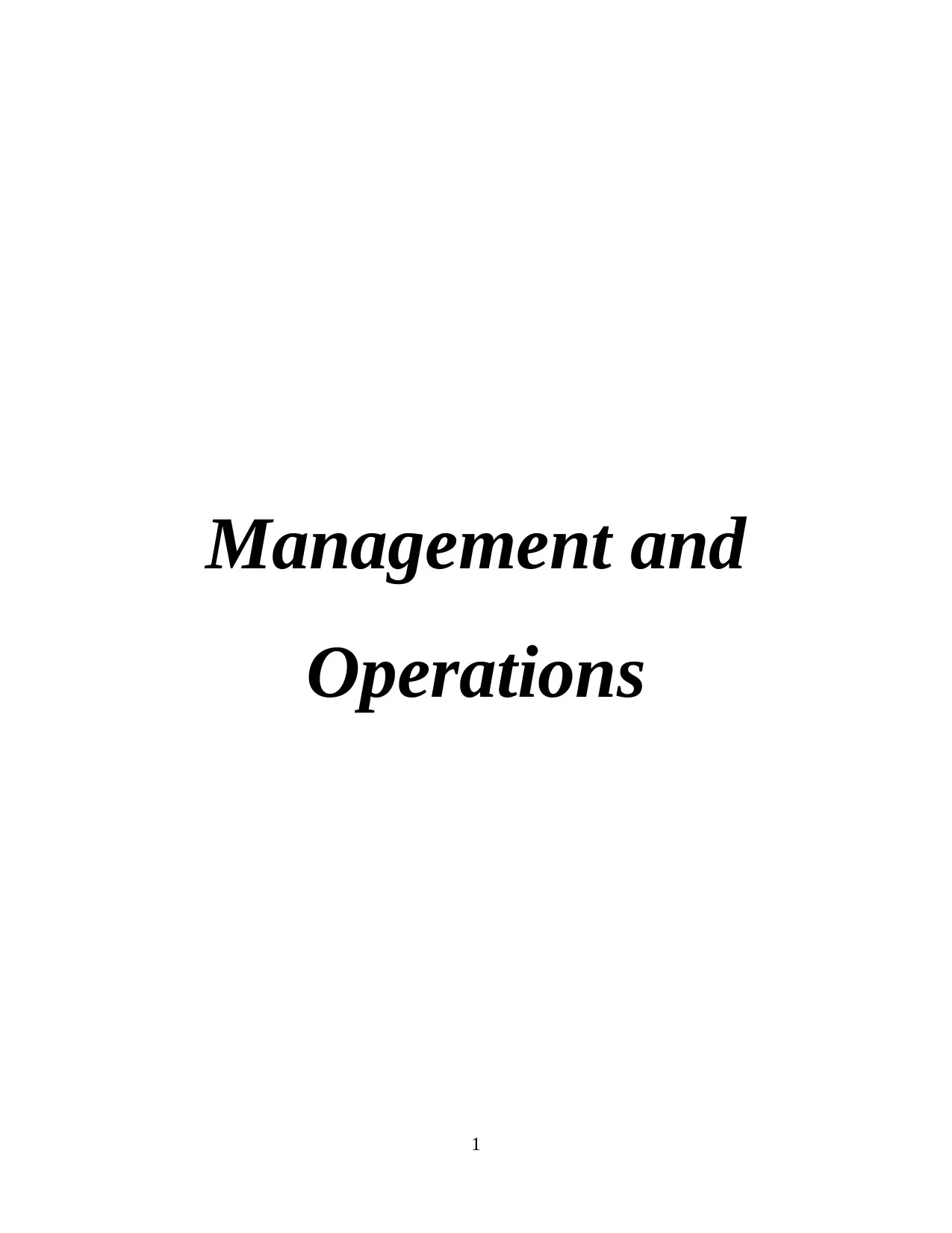
Management and
Operations
1
Operations
1
Paraphrase This Document
Need a fresh take? Get an instant paraphrase of this document with our AI Paraphraser
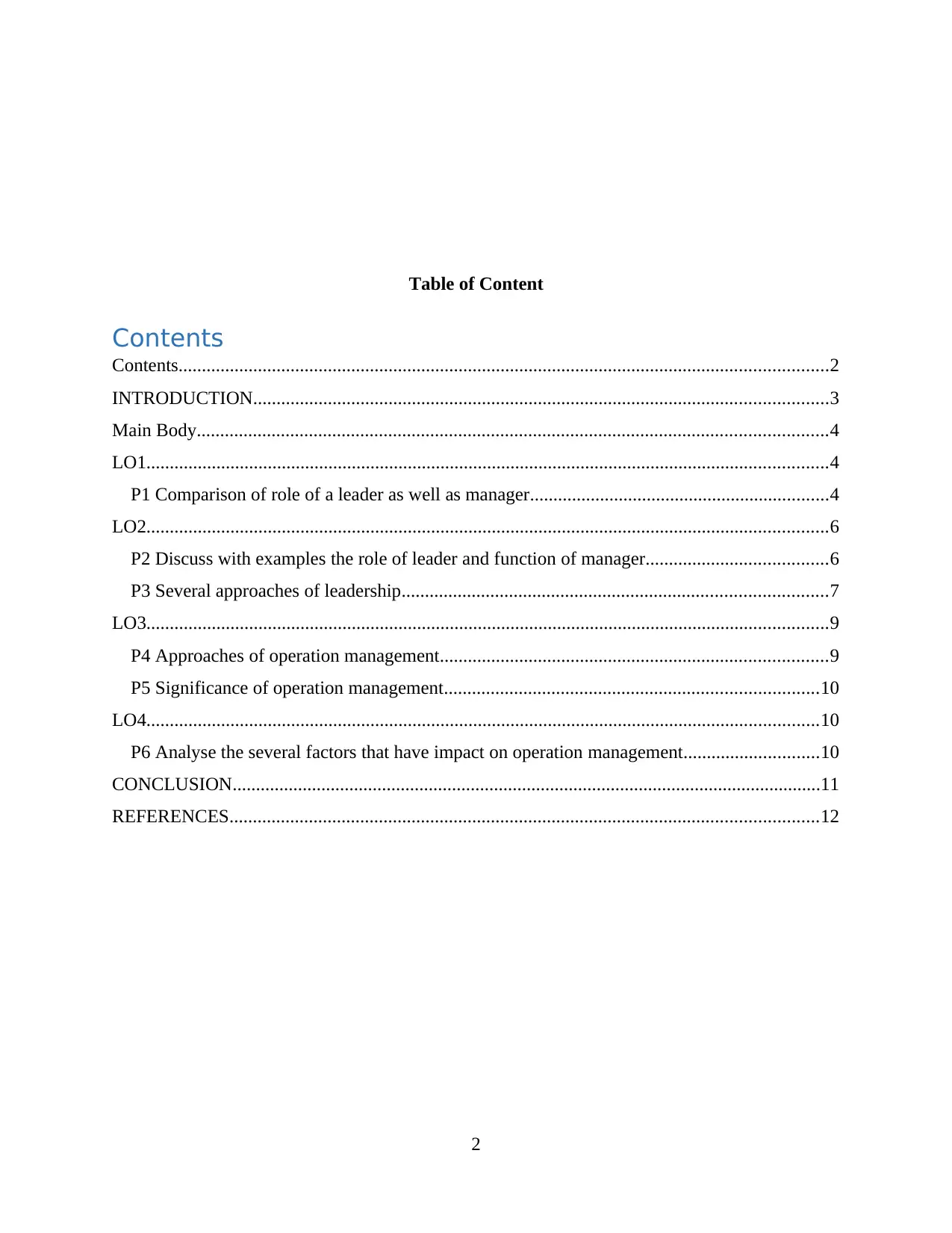
Table of Content
Contents
Contents...........................................................................................................................................2
INTRODUCTION...........................................................................................................................3
Main Body.......................................................................................................................................4
LO1..................................................................................................................................................4
P1 Comparison of role of a leader as well as manager................................................................4
LO2..................................................................................................................................................6
P2 Discuss with examples the role of leader and function of manager.......................................6
P3 Several approaches of leadership...........................................................................................7
LO3..................................................................................................................................................9
P4 Approaches of operation management...................................................................................9
P5 Significance of operation management................................................................................10
LO4................................................................................................................................................10
P6 Analyse the several factors that have impact on operation management.............................10
CONCLUSION..............................................................................................................................11
REFERENCES..............................................................................................................................12
2
Contents
Contents...........................................................................................................................................2
INTRODUCTION...........................................................................................................................3
Main Body.......................................................................................................................................4
LO1..................................................................................................................................................4
P1 Comparison of role of a leader as well as manager................................................................4
LO2..................................................................................................................................................6
P2 Discuss with examples the role of leader and function of manager.......................................6
P3 Several approaches of leadership...........................................................................................7
LO3..................................................................................................................................................9
P4 Approaches of operation management...................................................................................9
P5 Significance of operation management................................................................................10
LO4................................................................................................................................................10
P6 Analyse the several factors that have impact on operation management.............................10
CONCLUSION..............................................................................................................................11
REFERENCES..............................................................................................................................12
2
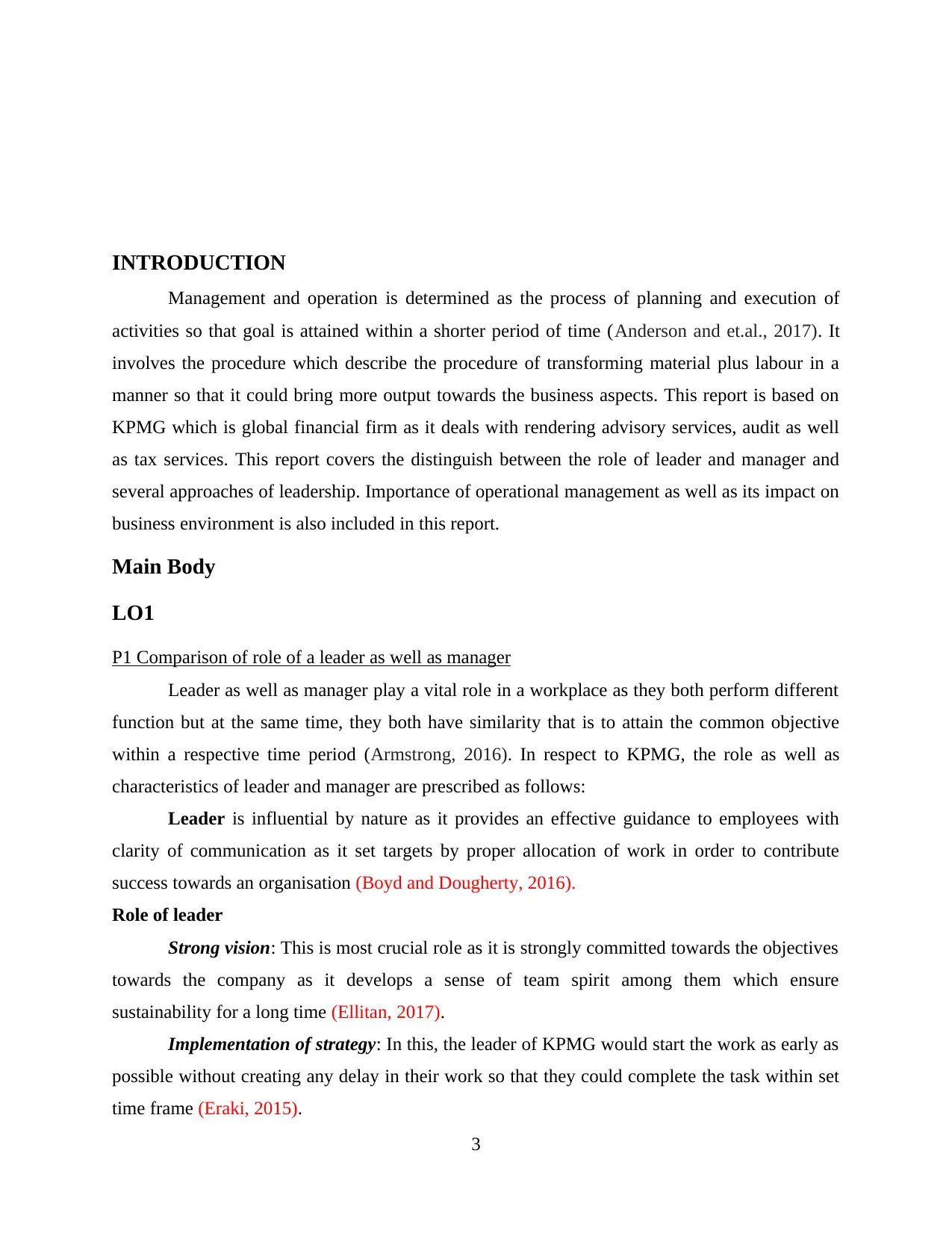
INTRODUCTION
Management and operation is determined as the process of planning and execution of
activities so that goal is attained within a shorter period of time (Anderson and et.al., 2017). It
involves the procedure which describe the procedure of transforming material plus labour in a
manner so that it could bring more output towards the business aspects. This report is based on
KPMG which is global financial firm as it deals with rendering advisory services, audit as well
as tax services. This report covers the distinguish between the role of leader and manager and
several approaches of leadership. Importance of operational management as well as its impact on
business environment is also included in this report.
Main Body
LO1
P1 Comparison of role of a leader as well as manager
Leader as well as manager play a vital role in a workplace as they both perform different
function but at the same time, they both have similarity that is to attain the common objective
within a respective time period (Armstrong, 2016). In respect to KPMG, the role as well as
characteristics of leader and manager are prescribed as follows:
Leader is influential by nature as it provides an effective guidance to employees with
clarity of communication as it set targets by proper allocation of work in order to contribute
success towards an organisation (Boyd and Dougherty, 2016).
Role of leader
Strong vision: This is most crucial role as it is strongly committed towards the objectives
towards the company as it develops a sense of team spirit among them which ensure
sustainability for a long time (Ellitan, 2017).
Implementation of strategy: In this, the leader of KPMG would start the work as early as
possible without creating any delay in their work so that they could complete the task within set
time frame (Eraki, 2015).
3
Management and operation is determined as the process of planning and execution of
activities so that goal is attained within a shorter period of time (Anderson and et.al., 2017). It
involves the procedure which describe the procedure of transforming material plus labour in a
manner so that it could bring more output towards the business aspects. This report is based on
KPMG which is global financial firm as it deals with rendering advisory services, audit as well
as tax services. This report covers the distinguish between the role of leader and manager and
several approaches of leadership. Importance of operational management as well as its impact on
business environment is also included in this report.
Main Body
LO1
P1 Comparison of role of a leader as well as manager
Leader as well as manager play a vital role in a workplace as they both perform different
function but at the same time, they both have similarity that is to attain the common objective
within a respective time period (Armstrong, 2016). In respect to KPMG, the role as well as
characteristics of leader and manager are prescribed as follows:
Leader is influential by nature as it provides an effective guidance to employees with
clarity of communication as it set targets by proper allocation of work in order to contribute
success towards an organisation (Boyd and Dougherty, 2016).
Role of leader
Strong vision: This is most crucial role as it is strongly committed towards the objectives
towards the company as it develops a sense of team spirit among them which ensure
sustainability for a long time (Ellitan, 2017).
Implementation of strategy: In this, the leader of KPMG would start the work as early as
possible without creating any delay in their work so that they could complete the task within set
time frame (Eraki, 2015).
3
⊘ This is a preview!⊘
Do you want full access?
Subscribe today to unlock all pages.

Trusted by 1+ million students worldwide
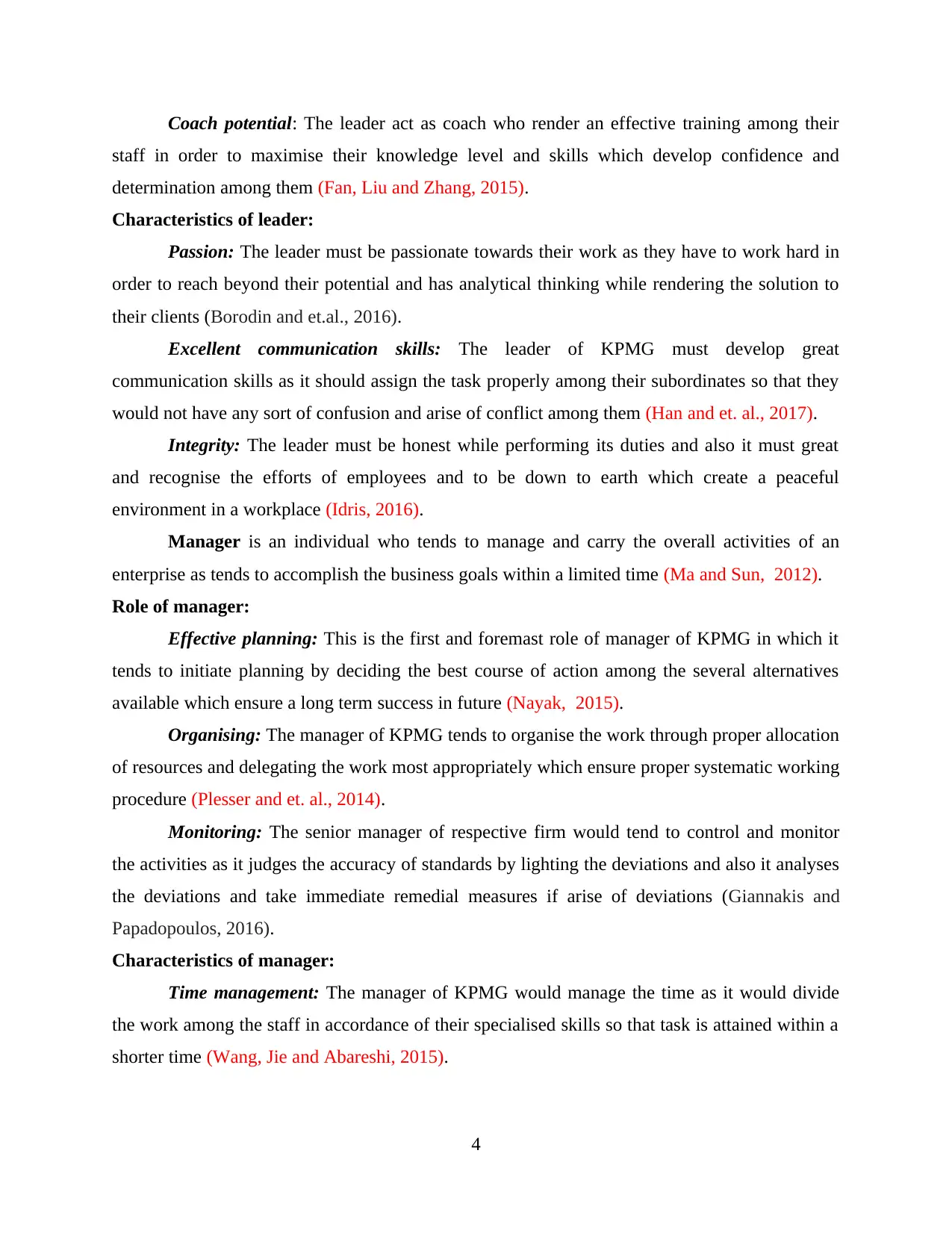
Coach potential: The leader act as coach who render an effective training among their
staff in order to maximise their knowledge level and skills which develop confidence and
determination among them (Fan, Liu and Zhang, 2015).
Characteristics of leader:
Passion: The leader must be passionate towards their work as they have to work hard in
order to reach beyond their potential and has analytical thinking while rendering the solution to
their clients (Borodin and et.al., 2016).
Excellent communication skills: The leader of KPMG must develop great
communication skills as it should assign the task properly among their subordinates so that they
would not have any sort of confusion and arise of conflict among them (Han and et. al., 2017).
Integrity: The leader must be honest while performing its duties and also it must great
and recognise the efforts of employees and to be down to earth which create a peaceful
environment in a workplace (Idris, 2016).
Manager is an individual who tends to manage and carry the overall activities of an
enterprise as tends to accomplish the business goals within a limited time (Ma and Sun, 2012).
Role of manager:
Effective planning: This is the first and foremast role of manager of KPMG in which it
tends to initiate planning by deciding the best course of action among the several alternatives
available which ensure a long term success in future (Nayak, 2015).
Organising: The manager of KPMG tends to organise the work through proper allocation
of resources and delegating the work most appropriately which ensure proper systematic working
procedure (Plesser and et. al., 2014).
Monitoring: The senior manager of respective firm would tend to control and monitor
the activities as it judges the accuracy of standards by lighting the deviations and also it analyses
the deviations and take immediate remedial measures if arise of deviations (Giannakis and
Papadopoulos, 2016).
Characteristics of manager:
Time management: The manager of KPMG would manage the time as it would divide
the work among the staff in accordance of their specialised skills so that task is attained within a
shorter time (Wang, Jie and Abareshi, 2015).
4
staff in order to maximise their knowledge level and skills which develop confidence and
determination among them (Fan, Liu and Zhang, 2015).
Characteristics of leader:
Passion: The leader must be passionate towards their work as they have to work hard in
order to reach beyond their potential and has analytical thinking while rendering the solution to
their clients (Borodin and et.al., 2016).
Excellent communication skills: The leader of KPMG must develop great
communication skills as it should assign the task properly among their subordinates so that they
would not have any sort of confusion and arise of conflict among them (Han and et. al., 2017).
Integrity: The leader must be honest while performing its duties and also it must great
and recognise the efforts of employees and to be down to earth which create a peaceful
environment in a workplace (Idris, 2016).
Manager is an individual who tends to manage and carry the overall activities of an
enterprise as tends to accomplish the business goals within a limited time (Ma and Sun, 2012).
Role of manager:
Effective planning: This is the first and foremast role of manager of KPMG in which it
tends to initiate planning by deciding the best course of action among the several alternatives
available which ensure a long term success in future (Nayak, 2015).
Organising: The manager of KPMG tends to organise the work through proper allocation
of resources and delegating the work most appropriately which ensure proper systematic working
procedure (Plesser and et. al., 2014).
Monitoring: The senior manager of respective firm would tend to control and monitor
the activities as it judges the accuracy of standards by lighting the deviations and also it analyses
the deviations and take immediate remedial measures if arise of deviations (Giannakis and
Papadopoulos, 2016).
Characteristics of manager:
Time management: The manager of KPMG would manage the time as it would divide
the work among the staff in accordance of their specialised skills so that task is attained within a
shorter time (Wang, Jie and Abareshi, 2015).
4
Paraphrase This Document
Need a fresh take? Get an instant paraphrase of this document with our AI Paraphraser
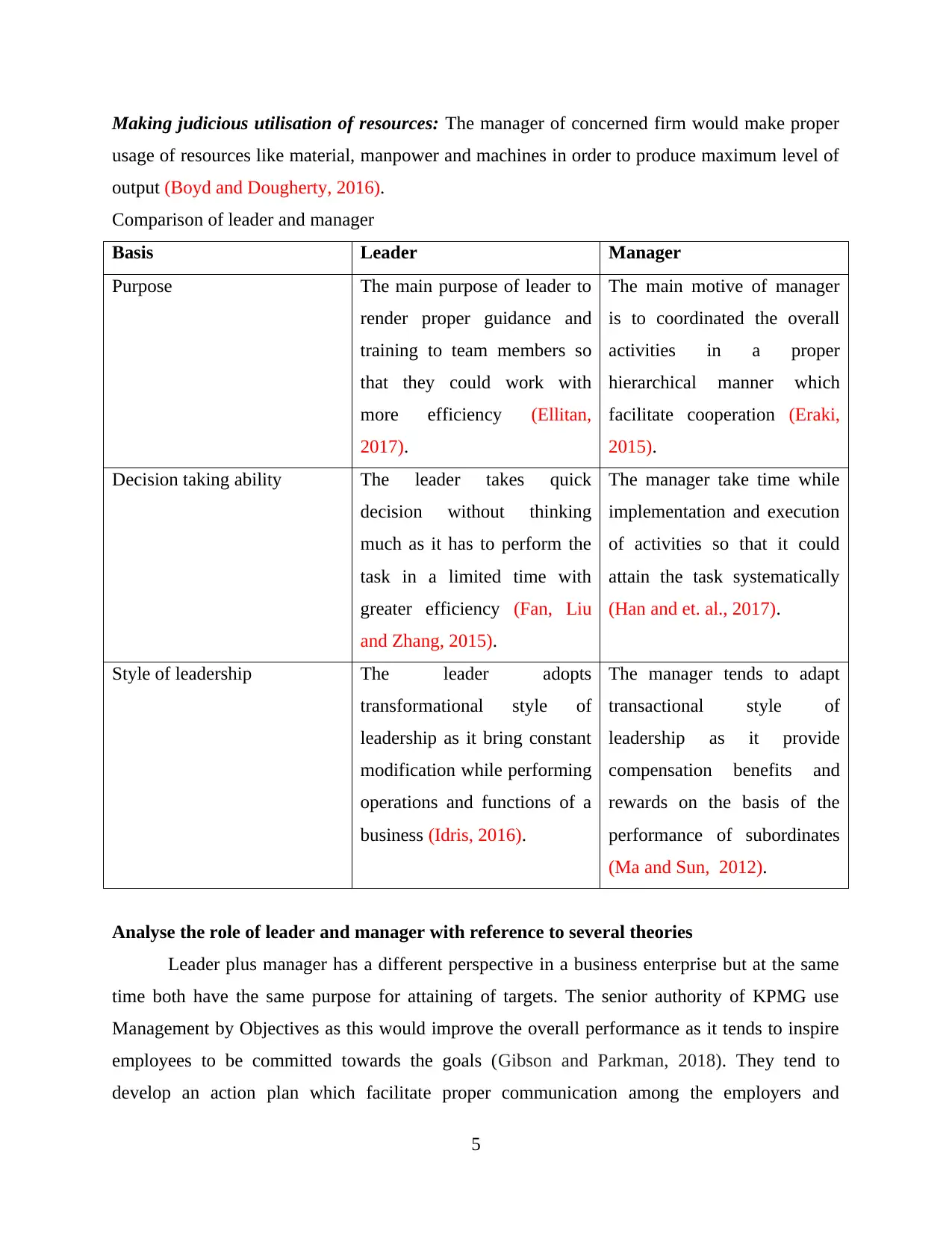
Making judicious utilisation of resources: The manager of concerned firm would make proper
usage of resources like material, manpower and machines in order to produce maximum level of
output (Boyd and Dougherty, 2016).
Comparison of leader and manager
Basis Leader Manager
Purpose The main purpose of leader to
render proper guidance and
training to team members so
that they could work with
more efficiency (Ellitan,
2017).
The main motive of manager
is to coordinated the overall
activities in a proper
hierarchical manner which
facilitate cooperation (Eraki,
2015).
Decision taking ability The leader takes quick
decision without thinking
much as it has to perform the
task in a limited time with
greater efficiency (Fan, Liu
and Zhang, 2015).
The manager take time while
implementation and execution
of activities so that it could
attain the task systematically
(Han and et. al., 2017).
Style of leadership The leader adopts
transformational style of
leadership as it bring constant
modification while performing
operations and functions of a
business (Idris, 2016).
The manager tends to adapt
transactional style of
leadership as it provide
compensation benefits and
rewards on the basis of the
performance of subordinates
(Ma and Sun, 2012).
Analyse the role of leader and manager with reference to several theories
Leader plus manager has a different perspective in a business enterprise but at the same
time both have the same purpose for attaining of targets. The senior authority of KPMG use
Management by Objectives as this would improve the overall performance as it tends to inspire
employees to be committed towards the goals (Gibson and Parkman, 2018). They tend to
develop an action plan which facilitate proper communication among the employers and
5
usage of resources like material, manpower and machines in order to produce maximum level of
output (Boyd and Dougherty, 2016).
Comparison of leader and manager
Basis Leader Manager
Purpose The main purpose of leader to
render proper guidance and
training to team members so
that they could work with
more efficiency (Ellitan,
2017).
The main motive of manager
is to coordinated the overall
activities in a proper
hierarchical manner which
facilitate cooperation (Eraki,
2015).
Decision taking ability The leader takes quick
decision without thinking
much as it has to perform the
task in a limited time with
greater efficiency (Fan, Liu
and Zhang, 2015).
The manager take time while
implementation and execution
of activities so that it could
attain the task systematically
(Han and et. al., 2017).
Style of leadership The leader adopts
transformational style of
leadership as it bring constant
modification while performing
operations and functions of a
business (Idris, 2016).
The manager tends to adapt
transactional style of
leadership as it provide
compensation benefits and
rewards on the basis of the
performance of subordinates
(Ma and Sun, 2012).
Analyse the role of leader and manager with reference to several theories
Leader plus manager has a different perspective in a business enterprise but at the same
time both have the same purpose for attaining of targets. The senior authority of KPMG use
Management by Objectives as this would improve the overall performance as it tends to inspire
employees to be committed towards the goals (Gibson and Parkman, 2018). They tend to
develop an action plan which facilitate proper communication among the employers and
5
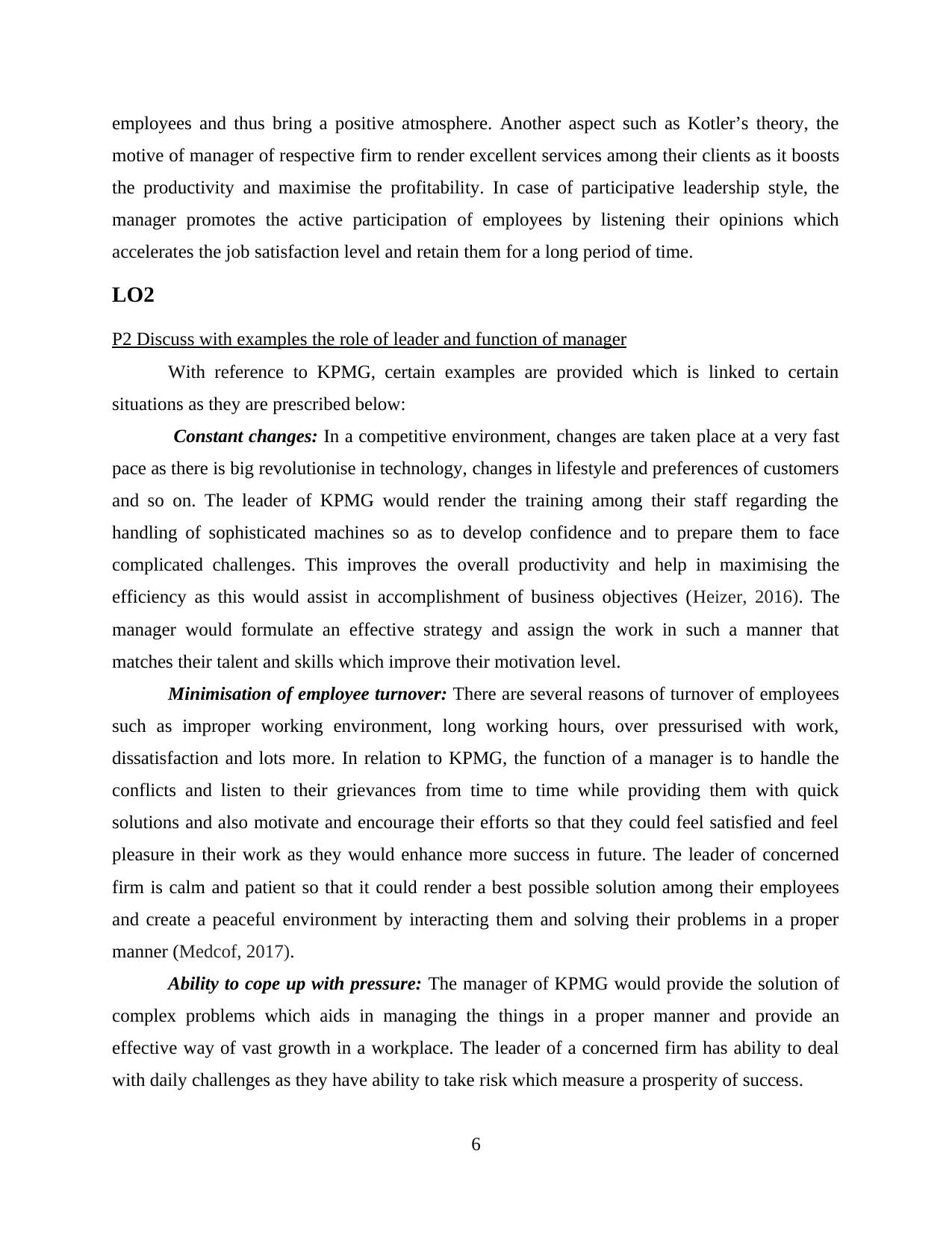
employees and thus bring a positive atmosphere. Another aspect such as Kotler’s theory, the
motive of manager of respective firm to render excellent services among their clients as it boosts
the productivity and maximise the profitability. In case of participative leadership style, the
manager promotes the active participation of employees by listening their opinions which
accelerates the job satisfaction level and retain them for a long period of time.
LO2
P2 Discuss with examples the role of leader and function of manager
With reference to KPMG, certain examples are provided which is linked to certain
situations as they are prescribed below:
Constant changes: In a competitive environment, changes are taken place at a very fast
pace as there is big revolutionise in technology, changes in lifestyle and preferences of customers
and so on. The leader of KPMG would render the training among their staff regarding the
handling of sophisticated machines so as to develop confidence and to prepare them to face
complicated challenges. This improves the overall productivity and help in maximising the
efficiency as this would assist in accomplishment of business objectives (Heizer, 2016). The
manager would formulate an effective strategy and assign the work in such a manner that
matches their talent and skills which improve their motivation level.
Minimisation of employee turnover: There are several reasons of turnover of employees
such as improper working environment, long working hours, over pressurised with work,
dissatisfaction and lots more. In relation to KPMG, the function of a manager is to handle the
conflicts and listen to their grievances from time to time while providing them with quick
solutions and also motivate and encourage their efforts so that they could feel satisfied and feel
pleasure in their work as they would enhance more success in future. The leader of concerned
firm is calm and patient so that it could render a best possible solution among their employees
and create a peaceful environment by interacting them and solving their problems in a proper
manner (Medcof, 2017).
Ability to cope up with pressure: The manager of KPMG would provide the solution of
complex problems which aids in managing the things in a proper manner and provide an
effective way of vast growth in a workplace. The leader of a concerned firm has ability to deal
with daily challenges as they have ability to take risk which measure a prosperity of success.
6
motive of manager of respective firm to render excellent services among their clients as it boosts
the productivity and maximise the profitability. In case of participative leadership style, the
manager promotes the active participation of employees by listening their opinions which
accelerates the job satisfaction level and retain them for a long period of time.
LO2
P2 Discuss with examples the role of leader and function of manager
With reference to KPMG, certain examples are provided which is linked to certain
situations as they are prescribed below:
Constant changes: In a competitive environment, changes are taken place at a very fast
pace as there is big revolutionise in technology, changes in lifestyle and preferences of customers
and so on. The leader of KPMG would render the training among their staff regarding the
handling of sophisticated machines so as to develop confidence and to prepare them to face
complicated challenges. This improves the overall productivity and help in maximising the
efficiency as this would assist in accomplishment of business objectives (Heizer, 2016). The
manager would formulate an effective strategy and assign the work in such a manner that
matches their talent and skills which improve their motivation level.
Minimisation of employee turnover: There are several reasons of turnover of employees
such as improper working environment, long working hours, over pressurised with work,
dissatisfaction and lots more. In relation to KPMG, the function of a manager is to handle the
conflicts and listen to their grievances from time to time while providing them with quick
solutions and also motivate and encourage their efforts so that they could feel satisfied and feel
pleasure in their work as they would enhance more success in future. The leader of concerned
firm is calm and patient so that it could render a best possible solution among their employees
and create a peaceful environment by interacting them and solving their problems in a proper
manner (Medcof, 2017).
Ability to cope up with pressure: The manager of KPMG would provide the solution of
complex problems which aids in managing the things in a proper manner and provide an
effective way of vast growth in a workplace. The leader of a concerned firm has ability to deal
with daily challenges as they have ability to take risk which measure a prosperity of success.
6
⊘ This is a preview!⊘
Do you want full access?
Subscribe today to unlock all pages.

Trusted by 1+ million students worldwide
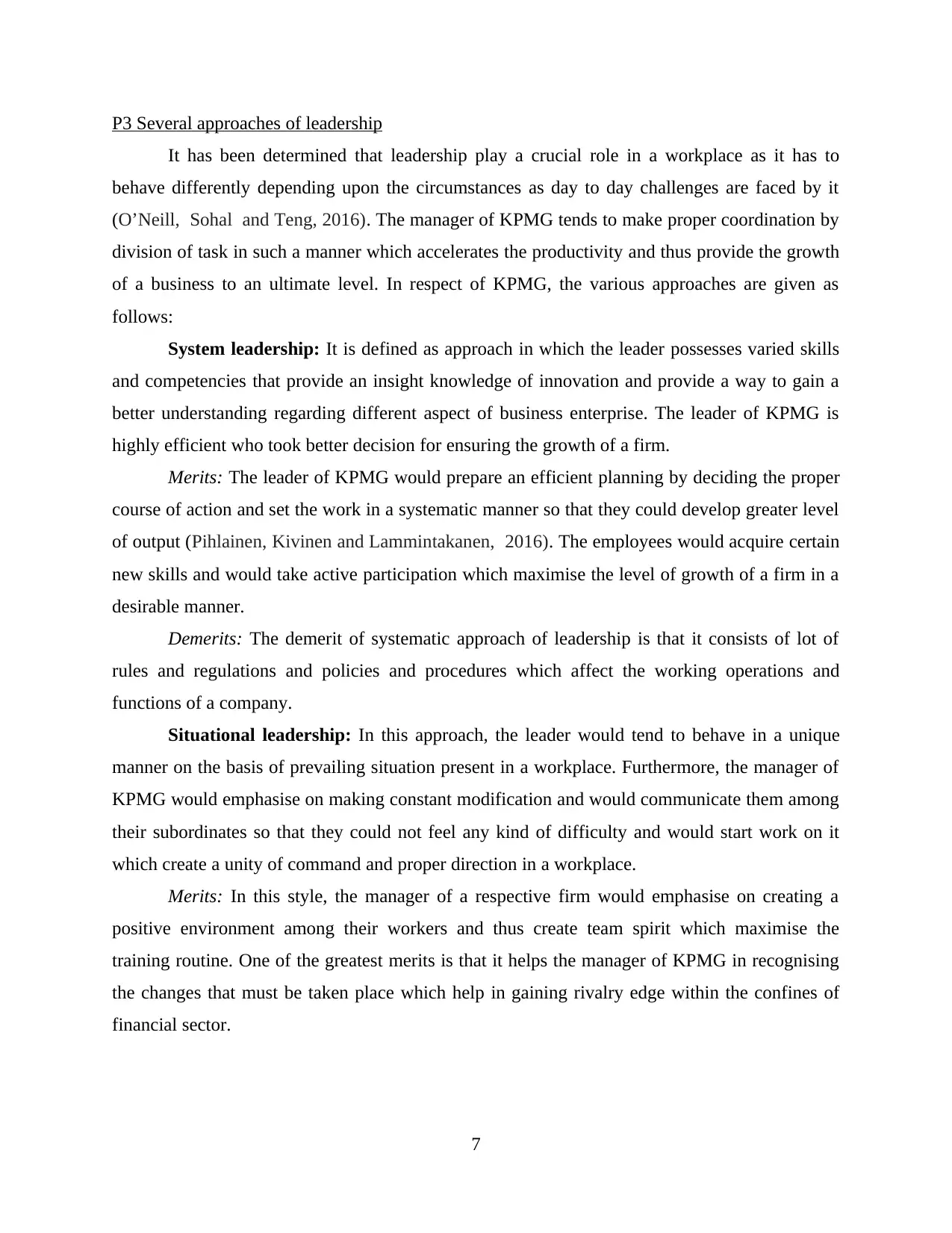
P3 Several approaches of leadership
It has been determined that leadership play a crucial role in a workplace as it has to
behave differently depending upon the circumstances as day to day challenges are faced by it
(O’Neill, Sohal and Teng, 2016). The manager of KPMG tends to make proper coordination by
division of task in such a manner which accelerates the productivity and thus provide the growth
of a business to an ultimate level. In respect of KPMG, the various approaches are given as
follows:
System leadership: It is defined as approach in which the leader possesses varied skills
and competencies that provide an insight knowledge of innovation and provide a way to gain a
better understanding regarding different aspect of business enterprise. The leader of KPMG is
highly efficient who took better decision for ensuring the growth of a firm.
Merits: The leader of KPMG would prepare an efficient planning by deciding the proper
course of action and set the work in a systematic manner so that they could develop greater level
of output (Pihlainen, Kivinen and Lammintakanen, 2016). The employees would acquire certain
new skills and would take active participation which maximise the level of growth of a firm in a
desirable manner.
Demerits: The demerit of systematic approach of leadership is that it consists of lot of
rules and regulations and policies and procedures which affect the working operations and
functions of a company.
Situational leadership: In this approach, the leader would tend to behave in a unique
manner on the basis of prevailing situation present in a workplace. Furthermore, the manager of
KPMG would emphasise on making constant modification and would communicate them among
their subordinates so that they could not feel any kind of difficulty and would start work on it
which create a unity of command and proper direction in a workplace.
Merits: In this style, the manager of a respective firm would emphasise on creating a
positive environment among their workers and thus create team spirit which maximise the
training routine. One of the greatest merits is that it helps the manager of KPMG in recognising
the changes that must be taken place which help in gaining rivalry edge within the confines of
financial sector.
7
It has been determined that leadership play a crucial role in a workplace as it has to
behave differently depending upon the circumstances as day to day challenges are faced by it
(O’Neill, Sohal and Teng, 2016). The manager of KPMG tends to make proper coordination by
division of task in such a manner which accelerates the productivity and thus provide the growth
of a business to an ultimate level. In respect of KPMG, the various approaches are given as
follows:
System leadership: It is defined as approach in which the leader possesses varied skills
and competencies that provide an insight knowledge of innovation and provide a way to gain a
better understanding regarding different aspect of business enterprise. The leader of KPMG is
highly efficient who took better decision for ensuring the growth of a firm.
Merits: The leader of KPMG would prepare an efficient planning by deciding the proper
course of action and set the work in a systematic manner so that they could develop greater level
of output (Pihlainen, Kivinen and Lammintakanen, 2016). The employees would acquire certain
new skills and would take active participation which maximise the level of growth of a firm in a
desirable manner.
Demerits: The demerit of systematic approach of leadership is that it consists of lot of
rules and regulations and policies and procedures which affect the working operations and
functions of a company.
Situational leadership: In this approach, the leader would tend to behave in a unique
manner on the basis of prevailing situation present in a workplace. Furthermore, the manager of
KPMG would emphasise on making constant modification and would communicate them among
their subordinates so that they could not feel any kind of difficulty and would start work on it
which create a unity of command and proper direction in a workplace.
Merits: In this style, the manager of a respective firm would emphasise on creating a
positive environment among their workers and thus create team spirit which maximise the
training routine. One of the greatest merits is that it helps the manager of KPMG in recognising
the changes that must be taken place which help in gaining rivalry edge within the confines of
financial sector.
7
Paraphrase This Document
Need a fresh take? Get an instant paraphrase of this document with our AI Paraphraser

Demerits: Some employees hesitate to accept the changes which create delay in working
procedure. Also, this approach only focus on short term needs instead of long term needs which
create an overburdened situation on the perspective side of manager.
Contingency leadership: In this, this approach focuses on matching the styles of
leadership as it must take right decision in a right place in a proper period of time. The leader
would focus on proper allocation of resources and task among the subordinates in order to avoid
duplication of activities and thus promote the growth of an organisation (Sameti and Haghighat,
2017).
Merits: One of the greatest strengths is that this style of leadership is dynamic in nature
so the manager of KPMG would make changes in policies and procedures that enhance the best
decision as it provide an approach among employees to share their ideas and thoughts towards
the business which render a vast growth.
Demerits: This style of leadership has a complex approach as sometimes manager find
difficult to handle the situation which create an inadequate circumstance. Also, this theory does
not work well in case of practical situations which affect the overall work of a company in an
adverse manner.
LO3
P4 Approaches of operation management
Operation management is better understood as the process of converting raw materials
into finished merchandise as the main motive of operation management is to make full utilisation
of resources so as to bring smooth flow of activities in a workplace (Schedlitzki and Edwards,
2017). The manager of KPMG tends to provide fast and efficient services among their clients by
which in turn generate and build trust among them. The role of operation manager is to focus
more on quality specification so as to build the hearts of customers which ensure long term
sustainability.
Cost of quality: This is better understood as a method which define the quantity of
resources to be used by an organisation so as to make sure that proper quality of product is
maintained. In simple words, the cost of quality is simply the cost which is associated with
quality with the aim of minimising the failure or defects from the product (Nayak, 2015).
With reference to KPMG, the approaches of same are elucidated below:
8
procedure. Also, this approach only focus on short term needs instead of long term needs which
create an overburdened situation on the perspective side of manager.
Contingency leadership: In this, this approach focuses on matching the styles of
leadership as it must take right decision in a right place in a proper period of time. The leader
would focus on proper allocation of resources and task among the subordinates in order to avoid
duplication of activities and thus promote the growth of an organisation (Sameti and Haghighat,
2017).
Merits: One of the greatest strengths is that this style of leadership is dynamic in nature
so the manager of KPMG would make changes in policies and procedures that enhance the best
decision as it provide an approach among employees to share their ideas and thoughts towards
the business which render a vast growth.
Demerits: This style of leadership has a complex approach as sometimes manager find
difficult to handle the situation which create an inadequate circumstance. Also, this theory does
not work well in case of practical situations which affect the overall work of a company in an
adverse manner.
LO3
P4 Approaches of operation management
Operation management is better understood as the process of converting raw materials
into finished merchandise as the main motive of operation management is to make full utilisation
of resources so as to bring smooth flow of activities in a workplace (Schedlitzki and Edwards,
2017). The manager of KPMG tends to provide fast and efficient services among their clients by
which in turn generate and build trust among them. The role of operation manager is to focus
more on quality specification so as to build the hearts of customers which ensure long term
sustainability.
Cost of quality: This is better understood as a method which define the quantity of
resources to be used by an organisation so as to make sure that proper quality of product is
maintained. In simple words, the cost of quality is simply the cost which is associated with
quality with the aim of minimising the failure or defects from the product (Nayak, 2015).
With reference to KPMG, the approaches of same are elucidated below:
8
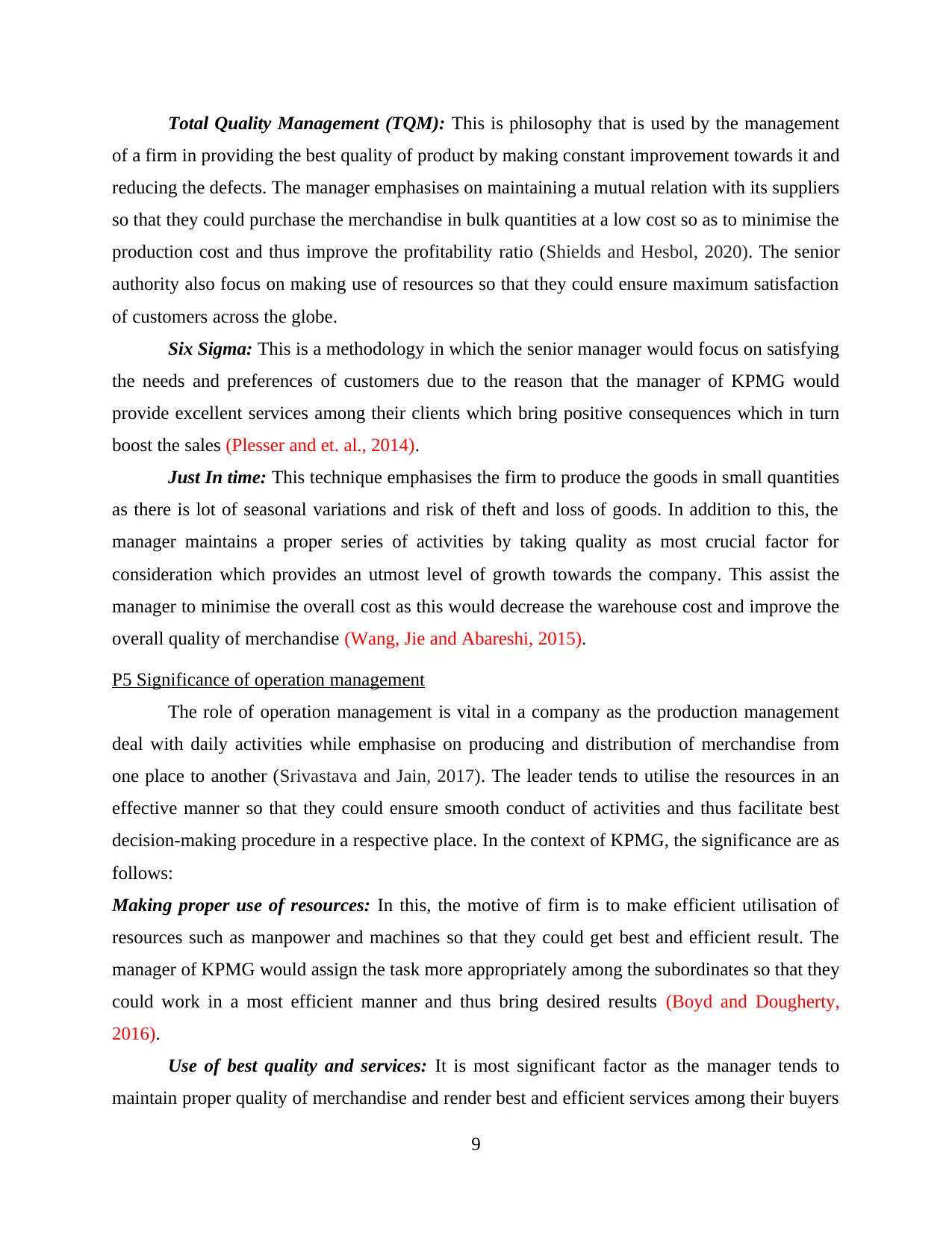
Total Quality Management (TQM): This is philosophy that is used by the management
of a firm in providing the best quality of product by making constant improvement towards it and
reducing the defects. The manager emphasises on maintaining a mutual relation with its suppliers
so that they could purchase the merchandise in bulk quantities at a low cost so as to minimise the
production cost and thus improve the profitability ratio (Shields and Hesbol, 2020). The senior
authority also focus on making use of resources so that they could ensure maximum satisfaction
of customers across the globe.
Six Sigma: This is a methodology in which the senior manager would focus on satisfying
the needs and preferences of customers due to the reason that the manager of KPMG would
provide excellent services among their clients which bring positive consequences which in turn
boost the sales (Plesser and et. al., 2014).
Just In time: This technique emphasises the firm to produce the goods in small quantities
as there is lot of seasonal variations and risk of theft and loss of goods. In addition to this, the
manager maintains a proper series of activities by taking quality as most crucial factor for
consideration which provides an utmost level of growth towards the company. This assist the
manager to minimise the overall cost as this would decrease the warehouse cost and improve the
overall quality of merchandise (Wang, Jie and Abareshi, 2015).
P5 Significance of operation management
The role of operation management is vital in a company as the production management
deal with daily activities while emphasise on producing and distribution of merchandise from
one place to another (Srivastava and Jain, 2017). The leader tends to utilise the resources in an
effective manner so that they could ensure smooth conduct of activities and thus facilitate best
decision-making procedure in a respective place. In the context of KPMG, the significance are as
follows:
Making proper use of resources: In this, the motive of firm is to make efficient utilisation of
resources such as manpower and machines so that they could get best and efficient result. The
manager of KPMG would assign the task more appropriately among the subordinates so that they
could work in a most efficient manner and thus bring desired results (Boyd and Dougherty,
2016).
Use of best quality and services: It is most significant factor as the manager tends to
maintain proper quality of merchandise and render best and efficient services among their buyers
9
of a firm in providing the best quality of product by making constant improvement towards it and
reducing the defects. The manager emphasises on maintaining a mutual relation with its suppliers
so that they could purchase the merchandise in bulk quantities at a low cost so as to minimise the
production cost and thus improve the profitability ratio (Shields and Hesbol, 2020). The senior
authority also focus on making use of resources so that they could ensure maximum satisfaction
of customers across the globe.
Six Sigma: This is a methodology in which the senior manager would focus on satisfying
the needs and preferences of customers due to the reason that the manager of KPMG would
provide excellent services among their clients which bring positive consequences which in turn
boost the sales (Plesser and et. al., 2014).
Just In time: This technique emphasises the firm to produce the goods in small quantities
as there is lot of seasonal variations and risk of theft and loss of goods. In addition to this, the
manager maintains a proper series of activities by taking quality as most crucial factor for
consideration which provides an utmost level of growth towards the company. This assist the
manager to minimise the overall cost as this would decrease the warehouse cost and improve the
overall quality of merchandise (Wang, Jie and Abareshi, 2015).
P5 Significance of operation management
The role of operation management is vital in a company as the production management
deal with daily activities while emphasise on producing and distribution of merchandise from
one place to another (Srivastava and Jain, 2017). The leader tends to utilise the resources in an
effective manner so that they could ensure smooth conduct of activities and thus facilitate best
decision-making procedure in a respective place. In the context of KPMG, the significance are as
follows:
Making proper use of resources: In this, the motive of firm is to make efficient utilisation of
resources such as manpower and machines so that they could get best and efficient result. The
manager of KPMG would assign the task more appropriately among the subordinates so that they
could work in a most efficient manner and thus bring desired results (Boyd and Dougherty,
2016).
Use of best quality and services: It is most significant factor as the manager tends to
maintain proper quality of merchandise and render best and efficient services among their buyers
9
⊘ This is a preview!⊘
Do you want full access?
Subscribe today to unlock all pages.

Trusted by 1+ million students worldwide
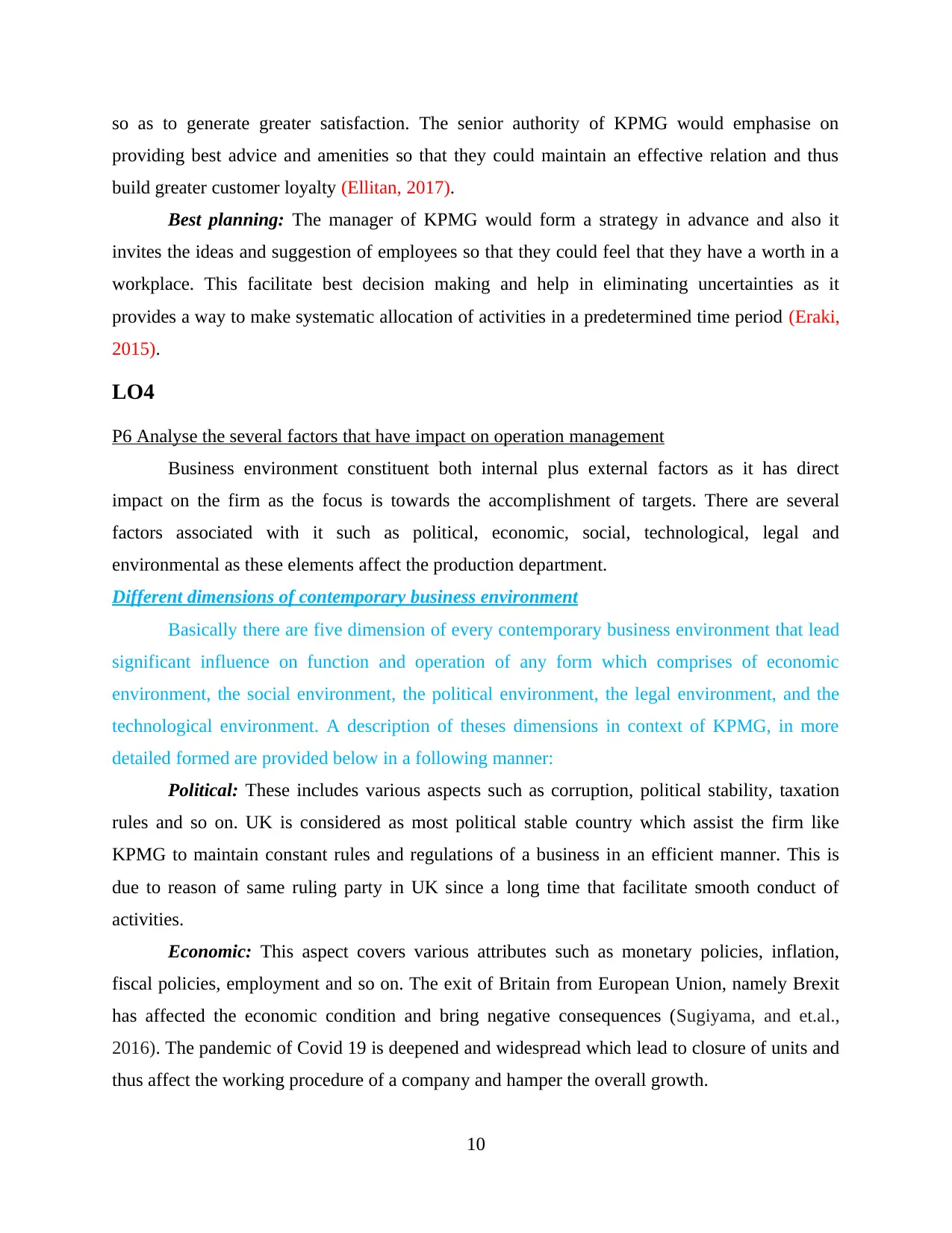
so as to generate greater satisfaction. The senior authority of KPMG would emphasise on
providing best advice and amenities so that they could maintain an effective relation and thus
build greater customer loyalty (Ellitan, 2017).
Best planning: The manager of KPMG would form a strategy in advance and also it
invites the ideas and suggestion of employees so that they could feel that they have a worth in a
workplace. This facilitate best decision making and help in eliminating uncertainties as it
provides a way to make systematic allocation of activities in a predetermined time period (Eraki,
2015).
LO4
P6 Analyse the several factors that have impact on operation management
Business environment constituent both internal plus external factors as it has direct
impact on the firm as the focus is towards the accomplishment of targets. There are several
factors associated with it such as political, economic, social, technological, legal and
environmental as these elements affect the production department.
Different dimensions of contemporary business environment
Basically there are five dimension of every contemporary business environment that lead
significant influence on function and operation of any form which comprises of economic
environment, the social environment, the political environment, the legal environment, and the
technological environment. A description of theses dimensions in context of KPMG, in more
detailed formed are provided below in a following manner:
Political: These includes various aspects such as corruption, political stability, taxation
rules and so on. UK is considered as most political stable country which assist the firm like
KPMG to maintain constant rules and regulations of a business in an efficient manner. This is
due to reason of same ruling party in UK since a long time that facilitate smooth conduct of
activities.
Economic: This aspect covers various attributes such as monetary policies, inflation,
fiscal policies, employment and so on. The exit of Britain from European Union, namely Brexit
has affected the economic condition and bring negative consequences (Sugiyama, and et.al.,
2016). The pandemic of Covid 19 is deepened and widespread which lead to closure of units and
thus affect the working procedure of a company and hamper the overall growth.
10
providing best advice and amenities so that they could maintain an effective relation and thus
build greater customer loyalty (Ellitan, 2017).
Best planning: The manager of KPMG would form a strategy in advance and also it
invites the ideas and suggestion of employees so that they could feel that they have a worth in a
workplace. This facilitate best decision making and help in eliminating uncertainties as it
provides a way to make systematic allocation of activities in a predetermined time period (Eraki,
2015).
LO4
P6 Analyse the several factors that have impact on operation management
Business environment constituent both internal plus external factors as it has direct
impact on the firm as the focus is towards the accomplishment of targets. There are several
factors associated with it such as political, economic, social, technological, legal and
environmental as these elements affect the production department.
Different dimensions of contemporary business environment
Basically there are five dimension of every contemporary business environment that lead
significant influence on function and operation of any form which comprises of economic
environment, the social environment, the political environment, the legal environment, and the
technological environment. A description of theses dimensions in context of KPMG, in more
detailed formed are provided below in a following manner:
Political: These includes various aspects such as corruption, political stability, taxation
rules and so on. UK is considered as most political stable country which assist the firm like
KPMG to maintain constant rules and regulations of a business in an efficient manner. This is
due to reason of same ruling party in UK since a long time that facilitate smooth conduct of
activities.
Economic: This aspect covers various attributes such as monetary policies, inflation,
fiscal policies, employment and so on. The exit of Britain from European Union, namely Brexit
has affected the economic condition and bring negative consequences (Sugiyama, and et.al.,
2016). The pandemic of Covid 19 is deepened and widespread which lead to closure of units and
thus affect the working procedure of a company and hamper the overall growth.
10
Paraphrase This Document
Need a fresh take? Get an instant paraphrase of this document with our AI Paraphraser

Social: In a modern era, there is changes in lifestyle as well as taste and preferences of
customers as the population in UK are modern who give more preference towards the education.
The manager of KPMG would tend to render effective and efficient services among the clients
which aids in retaining them.
Technological: UK is considered as the most technologically advanced country so
KPMG provide online facilities in order to provide them with greater ease of convenience to
them. This provide an easy access to them and thus maintain proper transparency.
Legal: These cover various aspects such as antitrust laws, patent, copyright, patent and so
on. It is mandate for the firm to protect intellectual rights so that their secrets would not be
leaked so the manager would ensure that it has patent and data protection act which maintain a
goodwill of the company. They also make sure that the senior executive would abide all rules
and regulations which bring accountability and proper recording of transactions in a workplace.
Environmental: This element emphasises on ensuring protection towards the
environment so as to create a positive reputation across the worldwide. The manager of KPMG
would strictly take care of environmental measures and adopt the strategy of waste management
by avoiding the spoilage of resources as this assist the firm in contribute towards significant
position within a marketplace.
The manager of KPMG would emphasise on corporate social responsibility and by
focussing towards the ecological balance which enhance the greater productivity. The impact of
Brexit and coronavirus would adversely affect the operations of the company and this led to
negative consequences.
Relationship between leadership and management has in the context of corporate social
responsibility, culture, values, ethics and sustainability
A vital role is lead by leadership and management in the context of managing and meting
corporate social responsibility, culture, values, ethics and sustainability of a firm. The concept of
CSR is mainly related with the taking out and performing business process in a way which
makes an organisation socially accountable for all of its customer, stakeholders and all other
individuals and associated parties of society. Thus, a crucial role is played by leadership and
management of KPMG company as they direct and guide its employees for performing or
operating its day to day function in a such way that enhance cultural value of society. At the
same time efforts are also made by the leadership and management of KPMG company to reduce
11
customers as the population in UK are modern who give more preference towards the education.
The manager of KPMG would tend to render effective and efficient services among the clients
which aids in retaining them.
Technological: UK is considered as the most technologically advanced country so
KPMG provide online facilities in order to provide them with greater ease of convenience to
them. This provide an easy access to them and thus maintain proper transparency.
Legal: These cover various aspects such as antitrust laws, patent, copyright, patent and so
on. It is mandate for the firm to protect intellectual rights so that their secrets would not be
leaked so the manager would ensure that it has patent and data protection act which maintain a
goodwill of the company. They also make sure that the senior executive would abide all rules
and regulations which bring accountability and proper recording of transactions in a workplace.
Environmental: This element emphasises on ensuring protection towards the
environment so as to create a positive reputation across the worldwide. The manager of KPMG
would strictly take care of environmental measures and adopt the strategy of waste management
by avoiding the spoilage of resources as this assist the firm in contribute towards significant
position within a marketplace.
The manager of KPMG would emphasise on corporate social responsibility and by
focussing towards the ecological balance which enhance the greater productivity. The impact of
Brexit and coronavirus would adversely affect the operations of the company and this led to
negative consequences.
Relationship between leadership and management has in the context of corporate social
responsibility, culture, values, ethics and sustainability
A vital role is lead by leadership and management in the context of managing and meting
corporate social responsibility, culture, values, ethics and sustainability of a firm. The concept of
CSR is mainly related with the taking out and performing business process in a way which
makes an organisation socially accountable for all of its customer, stakeholders and all other
individuals and associated parties of society. Thus, a crucial role is played by leadership and
management of KPMG company as they direct and guide its employees for performing or
operating its day to day function in a such way that enhance cultural value of society. At the
same time efforts are also made by the leadership and management of KPMG company to reduce
11
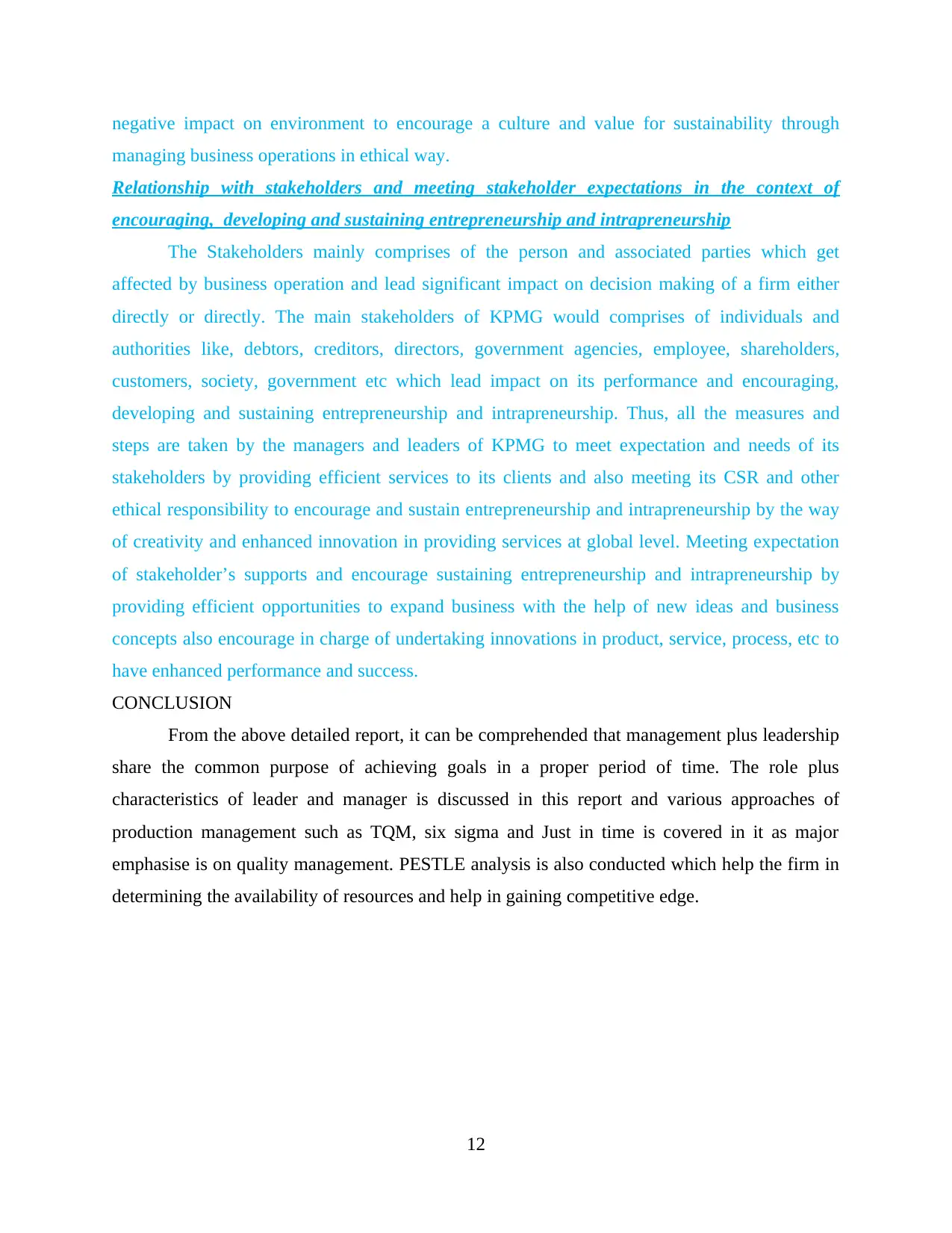
negative impact on environment to encourage a culture and value for sustainability through
managing business operations in ethical way.
Relationship with stakeholders and meeting stakeholder expectations in the context of
encouraging, developing and sustaining entrepreneurship and intrapreneurship
The Stakeholders mainly comprises of the person and associated parties which get
affected by business operation and lead significant impact on decision making of a firm either
directly or directly. The main stakeholders of KPMG would comprises of individuals and
authorities like, debtors, creditors, directors, government agencies, employee, shareholders,
customers, society, government etc which lead impact on its performance and encouraging,
developing and sustaining entrepreneurship and intrapreneurship. Thus, all the measures and
steps are taken by the managers and leaders of KPMG to meet expectation and needs of its
stakeholders by providing efficient services to its clients and also meeting its CSR and other
ethical responsibility to encourage and sustain entrepreneurship and intrapreneurship by the way
of creativity and enhanced innovation in providing services at global level. Meeting expectation
of stakeholder’s supports and encourage sustaining entrepreneurship and intrapreneurship by
providing efficient opportunities to expand business with the help of new ideas and business
concepts also encourage in charge of undertaking innovations in product, service, process, etc to
have enhanced performance and success.
CONCLUSION
From the above detailed report, it can be comprehended that management plus leadership
share the common purpose of achieving goals in a proper period of time. The role plus
characteristics of leader and manager is discussed in this report and various approaches of
production management such as TQM, six sigma and Just in time is covered in it as major
emphasise is on quality management. PESTLE analysis is also conducted which help the firm in
determining the availability of resources and help in gaining competitive edge.
12
managing business operations in ethical way.
Relationship with stakeholders and meeting stakeholder expectations in the context of
encouraging, developing and sustaining entrepreneurship and intrapreneurship
The Stakeholders mainly comprises of the person and associated parties which get
affected by business operation and lead significant impact on decision making of a firm either
directly or directly. The main stakeholders of KPMG would comprises of individuals and
authorities like, debtors, creditors, directors, government agencies, employee, shareholders,
customers, society, government etc which lead impact on its performance and encouraging,
developing and sustaining entrepreneurship and intrapreneurship. Thus, all the measures and
steps are taken by the managers and leaders of KPMG to meet expectation and needs of its
stakeholders by providing efficient services to its clients and also meeting its CSR and other
ethical responsibility to encourage and sustain entrepreneurship and intrapreneurship by the way
of creativity and enhanced innovation in providing services at global level. Meeting expectation
of stakeholder’s supports and encourage sustaining entrepreneurship and intrapreneurship by
providing efficient opportunities to expand business with the help of new ideas and business
concepts also encourage in charge of undertaking innovations in product, service, process, etc to
have enhanced performance and success.
CONCLUSION
From the above detailed report, it can be comprehended that management plus leadership
share the common purpose of achieving goals in a proper period of time. The role plus
characteristics of leader and manager is discussed in this report and various approaches of
production management such as TQM, six sigma and Just in time is covered in it as major
emphasise is on quality management. PESTLE analysis is also conducted which help the firm in
determining the availability of resources and help in gaining competitive edge.
12
⊘ This is a preview!⊘
Do you want full access?
Subscribe today to unlock all pages.

Trusted by 1+ million students worldwide
1 out of 14
Related Documents
Your All-in-One AI-Powered Toolkit for Academic Success.
+13062052269
info@desklib.com
Available 24*7 on WhatsApp / Email
![[object Object]](/_next/static/media/star-bottom.7253800d.svg)
Unlock your academic potential
Copyright © 2020–2025 A2Z Services. All Rights Reserved. Developed and managed by ZUCOL.





